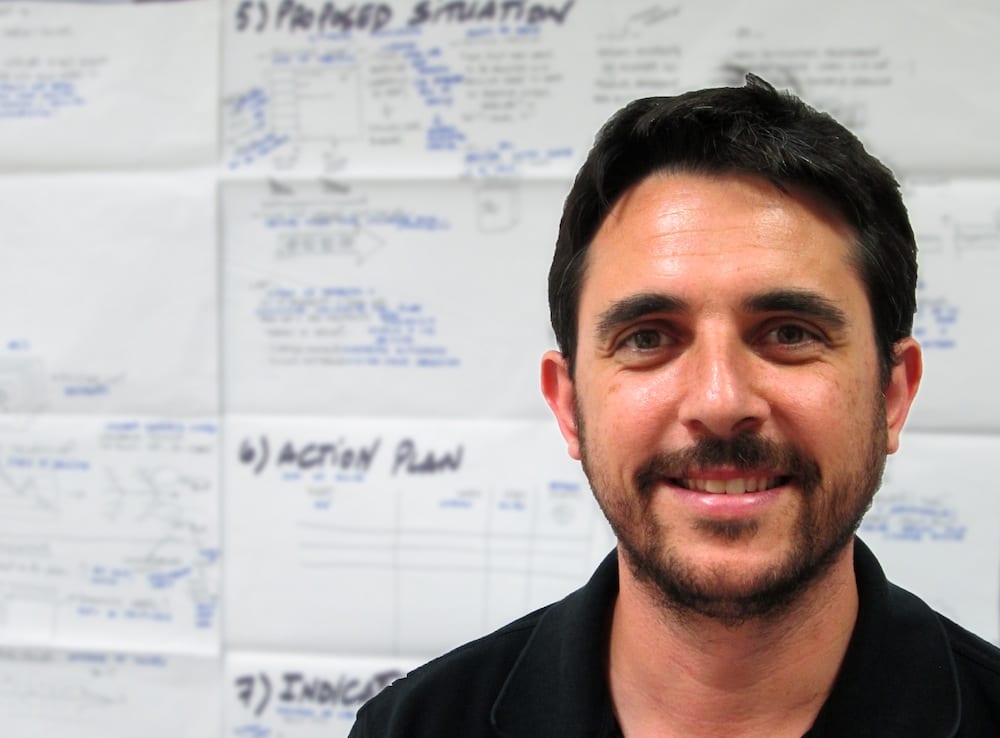
Get quick wins while ensuring a lasting transformation
FEATURE - Whether an organization pursues a lean transformation often depends on the early financial results - the low hanging fruit - it's able to achieve. This article offers a model to meet business needs while ensuring a transformation lasts.
Words: Nestor Gavilan, Lean Learning Director, Instituto Lean Management, Spain
Nothing makes us grow as much as making mistakes. Over time my understanding of what a lean transformation is has of course changed a lot, influenced by my many experiences and my professional development.
My years at Delphi were the first place where my lean ideas took shape and acquired strength. However, as far as transformations go, I must say that one of the projects I learned from the most was the one that Oriol Cuatrecasas (president of the Barcelona-based Instituto Lean Management) and I worked on years ago at a door manufacturer here in Spain.
The CEO wanted us to help him turn the business around, and we jumped right into it. We developed a very ambitious and intensive plan to transform the entire business: we taught people very foundational principles, as well as complex TPS tools; we dramatically changed the layout of the factory; and we introduced standard work.
We achieved truly incredible results: quality levels had never been higher, sales went through the roof (to over 1,000 doors sold per day), productivity increased by 40% in a year, and stock was reduced fivefold. Two years in, however, we started to wonder how sustainable these results were. Would the company be able to keep up the good work with me and Oriol gone?
And then one day it hit us: we had gone way too fast, trying to achieve massive results in a very short period of time. We had applied lean techniques to solve issues, but we didn’t have a clear strategy in place to change the culture of the organization in a sustainable way.
We then decided to hire someone with an automotive background to help us run the business. Three months in, the new manager called and told us that people did not “own” the system Oriol and I had created, and that he would have to re-teach them everything. In his words, he had “inherited a Ferrari and crashed it at the first curve.” The car was powerful, but there was nobody able to drive it.
This type of situation is far from uncommon in the business world, where the top management’s drive to transform a company often clashes with profit and loss sheets, financial targets, and cost saving initiatives. This results in most organizations expecting quick financial results, which can be achieved by simply applying a few lean tools, and deciding to stop there instead of pursuing a long lasting transformation.
What determines the direction in which the business will ultimately go depends on the approach of top management: without winning the hearts and minds of people, nothing more than fast-disappearing results will be accomplished.
To build a path to lasting improvement, leadership must draw a picture of the future of the business and give it to the people. But they must also develop leaders all the way to the front line, if they want that drawing not to fade once they are gone. This is what happened at the door manufacturer: we had not passed the teachings down to the front line of the organization, and as soon as we left the entire project fell apart.
We were in such a hurry to turn the business around that we had forgotten that lean calls for baby steps. Short-term thinking is the methodology’s worst enemy.
HOW THOSE LESSONS APPLY TODAY
I’ve recently been involved in the transformation of a large manufacturing organization with plants all over the world. Having realized that lean is the only way for businesses to ensure competitiveness and profitability in today’s volatile market, the board of the organization decided to concentrate on achieving a cultural turnaround.
For years the company had been using several lean tools (some of the senior executives, as it often happens, came from other large enterprises and were indeed familiar with the lean toolbox), but it was now after a more complete understanding of the type of change lean can lead to, while focusing more closely on the teachings of the Toyota Production System.
With no burning platform, the only incentive was the board’s drive to improve the organization. But this time I knew better.
Our starting point was to come up with a vision for the transformation. However, the board was expecting substantial financial results first. As previous experience taught me, we had to devise a vision that would allow for quick financial wins while paving the way for long lasting results. Let me tell you, it’s not an easy balance to strike.
My approach to a lean transformation is effectively represented in this drawing, the original version of which I sketched during a conversation with Planet Lean a few weeks ago:

The red area of the graph represents the business needs (grouped in the four most important elements for a company: Safety, Quality, Volume, Cost), which you can tackle quickly by using lean tools, while the green area represents the road to an actual lean transformation.
The basic idea behind business needs is to “do now” what is needed in order to deliver business results. I call this “buffet lean” – picking the tool needed to tackle a specific situation.
People often fall into the trap of thinking that this way they are actually mastering lean and that they are on their way to achieving a lean transformation. In fact, they are creating pockets of excellence. In most cases, at this point in time, doing 5S - for example - only means having two of the Ss in place, and achieving quicker changeovers has little meaning because it is not supported by standard work.
But in time, as you develop people’s capabilities and manage to change the company’s mindset, you’ll get to the point when you have both financial results and an infrastructure that allows you to build a lean enterprise. Completing a lean transformation is quite an investment!
HOW TO BEGIN
The focus on business needs is very big at first, and translates into pulling different tools to close your top gaps (still in a non-structured way). In order to identify these gaps, you must perform Gap Analysis, which is based on A3 thinking.
Here’s what to do to complete it:
- Pick the most critical element among Safety, Quality, Volume, Cost (starting from safety and following this order);
- Focus on the top three problems that are killing the business in that area, using Pareto analysis;
- Open an A3 for each of the three issues you identified.
There is no point in focusing on productivity (cost) or deliveries (volume), for example, if you have a lot of quality problems or if your facility has accidents every month. That’s why it is strongly recommended to tackle safety, quality, volume and cost in this order.
At this point, provided you have data from the past three months, you can organize your first kaizen event, which is aimed at teaching people about A3 thinking and at building the board you’ll use as reference in these first stages of the transition to becoming a leaner business. If you don’t have data covering the last three months, the first kaizen will have to be about building a system to take the necessary measurements and in this context a week can be used as a sample of what the trend have been over the past quarter.
PROGRESS
Once the business needs implementation is delivering results (SQVC), you will have the opportunity to start applying lean transformation principles and techniques. If for business needs the focus was on “do it now,” here it is on “do it right”.
At this stage, it’s necessary to pick the “granularity” of your implementation process. You need somewhere to begin, be it a model machine, a model line, a model area or a model plant: this is essential to win people over, because lean is learning by doing and only when you start doing something can you produce those quick results you are after.
Be aware that very soon, upon noticing the visible improvements on the model machine/line/area/plant, people will want the implementation to be extended to other parts of the business. As tempting as doing so might sound, you should resist the urge. It would be too soon to escalate now and you’d soon have a repeat of my experience and Oriol’s at the door manufacturer.
The model (machine, line, area or plant) must be protected and kept separated from the rest of the organization, where the business needs are being met. You can’t ask the model to contribute to the business: it’s where your experiments take place and where you are trying to build the foundations of the TPS house in a bottom-up way.
BUILDING ON INCREMENTAL IMPROVEMENTS
While your model is growing and slowly changing the culture of your organization, the rest of the company is working towards meeting business requirements using Gap Analysis in SQVC. Here they are using TPS-like tools, but not in a structured and bottom-up way, which is why whatever result they achieve in the business needs area is not sustainable. That’s what your model is focusing on instead: building the foundations for the TPS house, which will deliver long-lasting results and change the culture of the business for good.
To tackle the problems identified in the business needs area by means of the Gap Analysis, you can train people in the use of kaizen by organizing just-do-it, focused, and kaizen events. The more of these you do, the more improvements you will deliver. Some of them will be significant, others will be more modest - but together they will all contribute to reaching change across the business.
The reality is that the more you improve, the more finding further opportunities for improvement will feel like going mushroom picking: the first big ones will be easy to spot, but the more you pick the harder it will get to find those tiny mushrooms hiding in the groundcover. These will require a lot of time and effort – as the red part in the graph (business needs) clearly shows.
What the kaizen activity will do is bringing structure to the problem solving and improvement activities, in order to help you to sustain the results you accomplish in your model area. Top management can help with this by taking part in the improvement activities directly (for example checking on results and progress at the end of kaizen). But it’s also up to people in middle management to ensure kaizen results are long-term, by creating accountability through A3 reviews or attendance checks.
Going back to the graph, the activities in the business needs area feed into the lean transformation activities, because if you don’t provide quick improvements (and money) to the organization people will not support you further. At the same time, you need to learn how to use the tools if you are to master the use of the TPS house.
Once the model is consolidated with the entire TPS house in place, built from the bottom up (this normally takes two to three years), you can extend the reach of your lean efforts to other parts of the business. Starting from the pacemaker of the organization (in manufacturing, this is often production or packaging) and from there moving upstream and downstream, you can copy what you have done in the model and involve more and more people as you do so.
In my drawing, this is where the contamination begins. As the green area grows the red one shrinks because the principles are now well known and people observing the model area will want to replicate its success. Knowledge and change can now spread like wildfire.
What is behind the extraordinary power of a model area is the fact that it introduces a disruptive horizontal view of the organization: by essentially taking the TPS house to each of the departments involved in a given value stream, it allows for a system based on accountability (by appointing a value stream manager) and highlights the contribution of each activity to the final goal the vision has set for the organization.
Toyota gave us a successful model to follow and it’s up to you to adapt its teachings to your own circumstances. Because you are likely to need the money today in order to be able to do something good tomorrow, you might find it useful to follow this model, which the Instituto Lean Management in Spain is suggesting and following as it supports organizations in their attempt to turn around.
THE AUTHOR

Read more


FEATURE – The experience of solar company SunPower shows how, by marrying the concept of circular economy, lean principles can help us to transform our habits and save our planet.


CASE STUDY – This Turkish producer of sanitaryware has boosted its quality so dramatically it’s now a player in the German market. It did so by bringing drastic change to its production system.


FEATURE – The impact of humankind on the environment is now beyond dispute. Yet, too little is being done to adapt our business models. This compelling read explains why we need to create prosperity beyond profit.


RESEARCH - Offering us a glimpse into how the human mind works and into Toyota's approach to people engagement, this article tells us how to create a better working environment for our employees.

